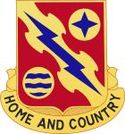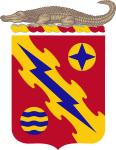265th Air Defense Artillery Regiment
| 265th Air Defense Artillery Regiment | |
|---|---|
 Distinctive unit insignia | |
| Active |
|
| Country | |
| Branch | Florida Army National Guard |
| Type |
|
| Garrison/HQ | Central Florida |
| Motto(s) | Home and Country |
| Battle honours | WWII
|

Alaskan Defense Command patch worn by the 265th while deployed to the Aleutian Islands in WWII.[2]
The 265th Air Defense Artillery Regiment is an air defense artillery regiment in the Florida Army National Guard. The unit was constituted 19 October 1923 in the Florida National Guard as the 1st Separate Battalion, Coast Artillery Corps. It was reorganized and redesignated as the 265th Coast Artillery Regiment (CA) (Harbor Defense) (HD) in 1929. The 265th was activated for World War II and served in the harbor defenses of Galveston, Texas, Los Angeles, California, Key West, Florida, Sandy Hook, New Jersey, and Alaska until broken up into battalions in July 1944.[1] The unit lineage was carried by two antiaircraft battalions organized in 1946, one of which was federalized in Florida during the Korean War. Consolidated with other units in 1959 as the 265th Artillery; reorganized in 1987 as the 265th Air Defense Artillery.[3]
Contents
1 Lineage
2 Campaign streamers
3 Coat of arms
3.1 Motto
3.2 Symbolism
3.3 Distinctive Insignia
4 See also
5 References
6 Further reading
7 External links
Lineage
Organized and federally recognized 14 November 1923 with headquarters at Jacksonville. Redesignated 4 April 1924 as the 1st Separate Battalion, Coast Artillery Corps. Redesignated 22 July 1925 as the 265th Coast Artillery Battalion. Expanded, reorganized, and redesignated 20 November 1929 as the 265th Coast Artillery Regiment.[3]
Inducted into federal service 6 January 1941 at home stations. Moved to Fort Crockett, Texas in the Harbor Defenses (HD) of Galveston, Texas 15 January 1941; operated these defenses alongside the regular army's 20th Coast Artillery Regiment.[4] In December 1941 2nd Battalion transferred to HD Los Angeles, California where stationed until April 1942 when regt ordered to Key West, Florida to man Fort Taylor in HD Key West, arriving 18 through 23 April 1942. Regiment operated HD Key West and various outposts in the Florida Keys and southern Florida until 21 December 1942 when movement to Fort Jackson, South Carolina began, lasting until 23 January 1943. On 16 February 1943 the 265th CA departed Fort Jackson for Fort Hancock, New Jersey in HD Sandy Hook. There the regiment helped operate the HD of Sandy Hook and the HD of Southern New York until 19 June 1943 when it prepared for overseas deployment.[1]
On 11 January 1944 the 265th CA departed New York for Fort Lawton, Washington state and deployment to Alaska, departing via the Seattle port of embarkation and arriving at Fort Greely in the HD of Kodiak, Alaska 24 January 1944. The 1st Battalion was transferred to Amchitka while the 2nd Battalion went to Adak, both in the Aleutian Islands.[1]
On 31 July 1944 the 265th CA (HD) Regt was inactivated and its elements redesignated. The Headquarters and Headquarters Battery (HHB) was disbanded and the 1st Battalion was redesignated the 277th CA (155-mm Gun) Bn (Sep) at Amchitka; the 2nd Battalion became the 278th CA (155-mm Gun) Bn (Sep) at Adak; and the 3rd Battalion, the 279th CA (155-mm Gun) Bn (Sep) at Shemya. The three battalions remained in the Aleutians through the end of the war, and were moved back to the United States via Seattle and inactivated in November 1945.[1][5]
Reconstituted 25 August 1945 in the Florida National Guard. Headquarters and 1st Battalion, 265th Coast Artillery, reorganized and federally recognized 5 December 1946 as the 692nd Antiaircraft Artillery Automatic Weapons Battalion, an element of the 48th Infantry Division (later designated as the 48th Armored Division), with headquarters at Jacksonville. Redesignated 1 February 1949 as the 148th Antiaircraft Artillery Battalion.[3]
2nd Battalion reorganized and federally recognized 17 December 1946 as the 712th Antiaircraft Artillery Gun Battalion with headquarters at Miami. Ordered into active federal service 1 May 1951 during the Korean War at home stations; released 30 April 1953 from active federal service and reverted to state control. Location of headquarters changed 22 June 1953 to Sarasota. Redesignated 1 October 1953 as the 712th Antiaircraft Artillery Battalion. (Headquarters Battery reorganized and federally recognized 15 September 1946 at Jacksonville as Headquarters and Headquarters Battery (HHB), 227th Antiaircraft Artillery Group; hereafter, separate lineage.) 148th and 712th Antiaircraft Artillery Battalions consolidated 15 April 1959 and consolidated unit reorganized and redesignated as the 265th Artillery, a parent regiment under the Combat Arms Regimental System, to consist of the 1st Automatic Weapons Battalion and the 2nd Howitzer Battalion. Reorganized 15 February 1963 to consist of the 1st and 2nd Automatic Weapons Battalions and the 16th and 17th Detachments. Reorganized 20 January 1968 to consist of the 1st Battalion.[3]
The 1st Battalion (Automatic Weapons) (Self-Propelled) was reorganized 1 October 1987 into the 1st and 3rd Battalions (Chaparral) with the HHB and Battery C forming HHB and Battery A of the 3rd Battalion. Withdrawn from the Combat Arms Regimental System 1 October 1987 and reorganized under the United States Army Regimental System with headquarters at Palatka, Florida.[3]
Campaign streamers
World War II
- Asiatic–Pacific theater without inscription[3]
Coat of arms

Motto
Home and Country[3]
Symbolism
The colors scarlet and yellow are used for artillery. The unit’s service in Alaska during World War II is denoted by the bezent, symbol for gold, and the four-pointed polar star. The diagonal stripe with the nebuly edges, heraldic symbol for clouds, bearing a lighting flash, signifies the Air Defense Artillery mission. The barry wavy rounded alludes to water and refers to the regiment’s former Coast Artillery service. Additionally, it indicates the organization’s location in Florida and refers to the legendary "Fountain of Youth" sought by Ponce de Leon, the discoverer of Florida. The alligator crest also represents the state of Florida.[3]
Distinctive Insignia
The distinctive unit insignia is the shield and motto of the coat of arms.[3]
See also
Escambia Rifles, a battery of the 265th Coast Artillery from 1936 - 1944.- Seacoast defense in the United States
- United States Army Coast Artillery Corps
- Harbor Defense Command
- Coats of arms of U.S. Air Defense Artillery Regiments
References
^ abcde Gaines, William C., Historical Sketches Coast Artillery Regiments 1917-1950, National Guard Army Regiments 197-265
^ Florida Department of Military Affairs, Special Archives Publication No. 119, 265th Coast Artillery, Select Abstract Biographies World War II. Saint Augustine, FL. Pg. 13. "Letter from Brig. Gen. Vernon F. Sykes to Charles H. Bogart, May 6, 1981." Retrieved from: http://ufdc.ufl.edu/UF00047666/00001
^ abcdefghi 265th Air Defense Artillery, Florida Army National Guard at Sill-www.army.mil This article incorporates text from this source, which is in the public domain.
This article incorporates text from this source, which is in the public domain.
^ Gaines, William C., Coast Artillery Organizational History, 1917-1950, Regular Army regiments, Coast Defense Journal, vol. 23, issue 2, pp. 13–14
^ Stanton, Shelby L. (1991). World War II Order of Battle. Galahad Books. pp. 472, 493. ISBN 0-88365-775-9..mw-parser-output cite.citation{font-style:inherit}.mw-parser-output .citation q{quotes:"""""""'""'"}.mw-parser-output .citation .cs1-lock-free a{background:url("//upload.wikimedia.org/wikipedia/commons/thumb/6/65/Lock-green.svg/9px-Lock-green.svg.png")no-repeat;background-position:right .1em center}.mw-parser-output .citation .cs1-lock-limited a,.mw-parser-output .citation .cs1-lock-registration a{background:url("//upload.wikimedia.org/wikipedia/commons/thumb/d/d6/Lock-gray-alt-2.svg/9px-Lock-gray-alt-2.svg.png")no-repeat;background-position:right .1em center}.mw-parser-output .citation .cs1-lock-subscription a{background:url("//upload.wikimedia.org/wikipedia/commons/thumb/a/aa/Lock-red-alt-2.svg/9px-Lock-red-alt-2.svg.png")no-repeat;background-position:right .1em center}.mw-parser-output .cs1-subscription,.mw-parser-output .cs1-registration{color:#555}.mw-parser-output .cs1-subscription span,.mw-parser-output .cs1-registration span{border-bottom:1px dotted;cursor:help}.mw-parser-output .cs1-ws-icon a{background:url("//upload.wikimedia.org/wikipedia/commons/thumb/4/4c/Wikisource-logo.svg/12px-Wikisource-logo.svg.png")no-repeat;background-position:right .1em center}.mw-parser-output code.cs1-code{color:inherit;background:inherit;border:inherit;padding:inherit}.mw-parser-output .cs1-hidden-error{display:none;font-size:100%}.mw-parser-output .cs1-visible-error{font-size:100%}.mw-parser-output .cs1-maint{display:none;color:#33aa33;margin-left:0.3em}.mw-parser-output .cs1-subscription,.mw-parser-output .cs1-registration,.mw-parser-output .cs1-format{font-size:95%}.mw-parser-output .cs1-kern-left,.mw-parser-output .cs1-kern-wl-left{padding-left:0.2em}.mw-parser-output .cs1-kern-right,.mw-parser-output .cs1-kern-wl-right{padding-right:0.2em}
Further reading
Berhow, Mark A., Ed. (2015). American Seacoast Defenses, A Reference Guide, Third Edition. McLean, Virginia: CDSG Press. ISBN 978-0-9748167-3-9.
External links
- Coast Defense Study Group website
Greg Hagg; Bolling Smith; Mark Berhow. "Insignia of the Coast Artillery Corps" (PDF). The Coast Defense Study Group, Inc. Retrieved 18 May 2018.
